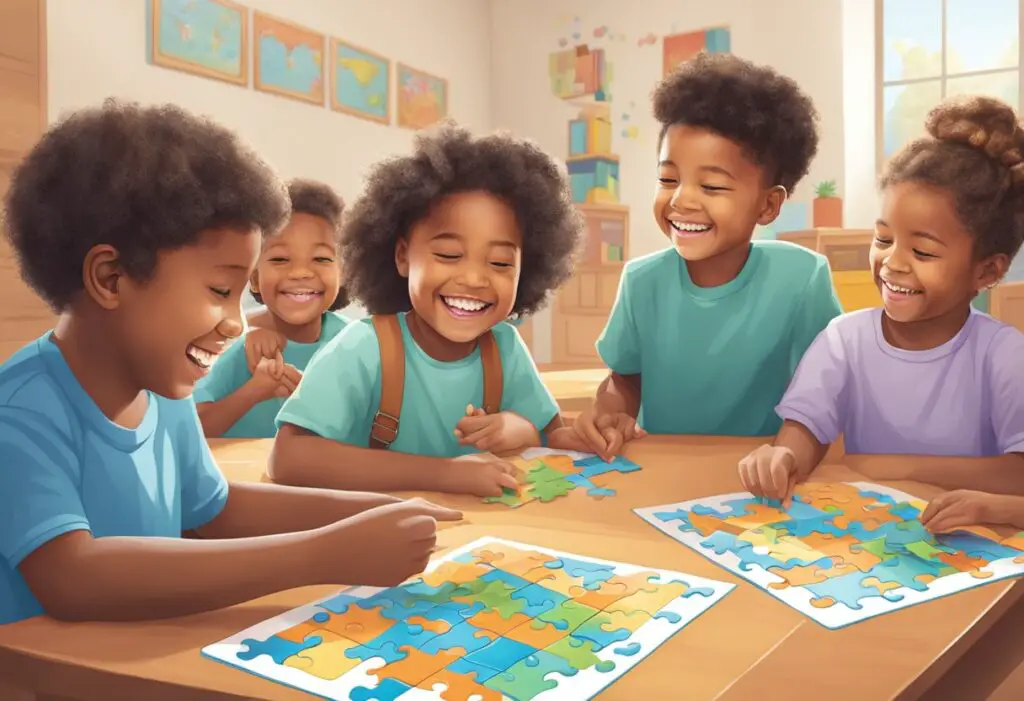So, you want to teach your kids about growth mindset? Well, you’re in luck because there are plenty of lessons and activities out there that can help. But first, let’s make sure we’re on the same page about what a growth mindset actually is.
According to Dr. Carol Dweck, a psychologist at Stanford University, a growth mindset is the belief that your abilities and intelligence can be developed through hard work, dedication, and perseverance. This is in contrast to a fixed mindset, which is the belief that your abilities and intelligence are set in stone and cannot be changed.

Now that we know what a growth mindset is, it’s time to start teaching it to your kids. But how do you do that? Well, there are a few key things to keep in mind. First, it’s important to praise effort, not just talent or intelligence. This helps kids understand that hard work and dedication are what leads to success, not just natural ability. Second, it’s important to encourage kids to take on challenges and embrace failure as an opportunity to learn and grow. Finally, it’s important to model a growth mindset yourself so your kids can see firsthand how it works in action. With these tips in mind, you’ll be well on your way to helping your kids develop a growth mindset that will serve them well throughout their lives.
The Brainy Business of Growth Mindset
If you’re looking to nurture a growth mindset in kids, it’s important to understand the brainy business behind it. After all, it’s the brain that’s responsible for our intelligence, abilities, and potential. In this section, we’ll take a closer look at the muscle called the brain and the unsung heroes known as neurons.
The Muscle Called Brain
Your brain is like a muscle – the more you use it, the stronger it gets. And just like any other muscle, it needs exercise to grow. That’s where the growth mindset comes in. By believing that your brain can grow and you can learn new things, you’re giving it the exercise it needs to become stronger.
But how does the brain actually grow? It’s all thanks to a process called neuroplasticity. This is the brain’s ability to change and adapt in response to new experiences. So, when you learn something new, your brain forms new connections between neurons, making it easier to recall that information in the future.
Neurons: The Unsung Heroes
Speaking of neurons, these tiny cells are the unsung heroes of the brain. They’re responsible for transmitting information throughout the brain and body, making it possible for us to think, move, and feel.
But here’s the thing – neurons aren’t fixed. They can change and adapt, just like the brain itself. By engaging in new experiences and learning new things, you’re actually creating new connections between neurons. This is what makes it possible for the brain to grow and change over time.
-

Bold Male Pride – Baseball Trucker Cap Celebrating Masculinity
£18.00 Select options This product has multiple variants. The options may be chosen on the product page -

Dad Bod Appreciation Gift Mug
£14.00 Add to cart -

Dad Bod, Bad Jokes Structured Baseball Cap
£22.00 Select options This product has multiple variants. The options may be chosen on the product page
So, the next time you’re thinking about growth mindset lessons for kids, remember that it’s all about exercising the brain and giving those neurons a workout. By doing so, you’re helping to nurture a growth mindset and unlock your child’s full potential.
The Art of Learning and Growing

So, you want to teach your kids about a growth mindset? Well, buckle up and get ready for some fun because the art of learning and growing is a wild ride!
First things first, let’s talk about the process of learning. It’s not always easy, but it’s always worth it. Learning takes time, effort, and work. But don’t worry; your little ones are up for the challenge! Encourage them to embrace the process of learning and to keep trying even when things get tough.
Speaking of trying, let’s talk about the importance of practice. Practice makes perfect, right? Well, not exactly. Practice makes progress. It’s all about putting in the effort and seeing improvement over time. So, encourage your kids to keep practicing, even when they feel like giving up.
But what about problem-solving? That’s a huge part of the learning process! Encourage your kids to think outside the box and come up with creative solutions to problems. Remind them that there’s no one right way to do things and that mistakes are just opportunities to learn and grow.
Finally, let’s talk about mastery. It’s not about being perfect; it’s about doing your best and constantly improving. Encourage your kids to set goals and work towards them, celebrating their progress along the way.
In summary, the art of learning and growing is all about embracing the process, putting in the effort, practicing, problem-solving, and working toward mastery. So, grab your little ones, and let’s start this wild ride together!
The Great Mindset Face-off: Fixed vs Growth
Welcome to the ultimate showdown between two opposing mindsets: Fixed and Growth. In the blue corner, we have Fixed Mindset, the heavyweight champion of the world of excuses, and in the red corner, we have Growth Mindset, the challenger, the underdog, the Rocky Balboa of the mindset world.
Fixed Mindset is all about staying in your comfort zone, avoiding challenges, and fearing failure. On the other hand, Growth Mindset is all about embracing challenges, learning from mistakes, and persevering through adversity.
Fixed Mindset believes that success is all about innate talent and intelligence, while Growth Mindset believes that success is a result of hard work and dedication.
Fixed Mindset is like a fragile vase, afraid of any cracks or chips, while Growth Mindset is like a rubber ball, bouncing back from any setback.
Fixed Mindset says “I can’t do it,” while Growth Mindset says “I can’t do it yet.”
Fixed Mindset is like a dead-end street, while Growth Mindset is like a winding road full of possibilities and opportunities.
So, which mindset will you choose? Will you stick with a Fixed Mindset and limit your potential, or will you embrace a Growth Mindset and unlock your true abilities? The choice is yours, but remember, as Henry Ford once said, “Whether you think you can or you think you can’t – you’re right.”
Fun and Games with a Growth Mindset

Who says learning can’t be fun? Incorporating games and activities into your growth mindset lessons can keep your students engaged and motivated. Here are some ideas to get you started:
Growth Mindset Bingo
Bingo is a classic game that can be easily adapted to reinforce growth mindset concepts. Create bingo cards with growth mindset phrases or quotes, such as “I can learn anything I want to” or “Mistakes help me learn.” Call out the phrases and have students mark off the corresponding squares on their cards. The first student to get a bingo wins a prize!
Growth Mindset Videos
Videos are a great way to introduce growth mindset concepts to students. There are plenty of videos available online that are both educational and entertaining. Check out this video from ClassDojo, which features a cast of cute monsters learning about the power of yet.
Growth Mindset Posters
Brighten up your classroom with growth mindset posters! Create posters with inspiring quotes or phrases that promote a growth mindset, such as “I can do hard things” or “I embrace challenges.” Hang them up on your bulletin board or around the classroom to remind students to keep a growth mindset.
Growth Mindset Scavenger Hunt
Turn learning into an adventure with a growth mindset scavenger hunt! Create a list of growth mindset concepts or quotes and hide them around the classroom. Give students a set amount of time to find as many as they can. The student who finds the most wins a prize!
Incorporating fun activities and games into your growth mindset lessons can help students stay engaged and motivated. Try out some of these ideas and watch your students’ growth mindset flourish!
Fostering Growth Mindset: Home and School
So, you want to help your kids develop a growth mindset? Great! You’re in the right place. Whether you’re a teacher or a parent, there are plenty of ways to encourage a growth mindset at home and in the classroom.
Home
At home, there are a few things you can do to foster a growth mindset in your kids. First, praise effort, not just achievement. When your child works hard, even if they don’t get the best grade or score, acknowledge the effort they put in. This will help them understand that effort is just as important as the end result.
Another way to encourage a growth mindset at home is to model it yourself. Talk about your own challenges and how you overcame them. This will show your child that it’s okay to make mistakes and that learning from them is an important part of the process.
School
In the classroom, teachers can use a variety of resources to help students develop a growth mindset. For example, they can use Growth Mindset Posters to remind students of the importance of effort and perseverance. Teachers can also use Growth Mindset Books to help students understand the concept and how it applies to their own lives.
Parents can also get involved in their child’s education by providing resources at home. For example, they can use Growth Mindset Worksheets to help their child practice the skills they’re learning in class. They can also read Growth Mindset Articles to learn more about the concept and how to apply it in their own lives.
Overall, fostering a growth mindset takes effort and patience. But with the right resources and support, you can help your child develop the skills they need to succeed in school and beyond.
The Power of Words in Shaping Mindsets
As a parent or teacher, you have the power to shape a child’s mindset by the words you use. The way you praise a child can either reinforce a fixed mindset or encourage a growth mindset. For example, saying “You’re so smart” may make a child feel good at the moment, but it can also create a fixed mindset where the child believes intelligence is innate and unchangeable. Instead, try praising the effort and hard work the child put in, such as “I’m proud of you for working so hard on that.”
Feedback is also an important tool for shaping mindsets. Constructive feedback that focuses on the process rather than the outcome can help children develop a growth mindset. For example, instead of saying, “You got an A, good job!” try saying, “I can see you put a lot of effort into studying for that test, and it paid off with a great grade.” This type of feedback emphasizes the effort and hard work that went into achieving the outcome, rather than just the outcome itself.
The language and vocabulary you use can also have an impact on a child’s mindset. Encourage the use of growth mindset language, such as “I can’t do it yet, but I’m working on it” instead of “I can’t do it.” This type of language emphasizes the idea that abilities can be developed over time with effort and hard work.
Finally, self-talk is an important aspect of mindset. Teach children to use positive self-talk, such as “I can do this” or “I’m getting better every day.” Encourage them to reframe negative self-talk into positive self-talk by asking questions like “Is there another way to think about this?” or “What can I learn from this?”
In summary, the words you use as a parent or teacher can have a powerful impact on a child’s mindset. By using growth mindset language, praising effort over innate ability, and providing constructive feedback that focuses on the process, you can help children develop a growth mindset that will serve them well throughout their lives.







